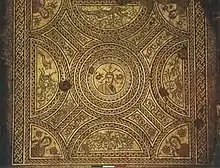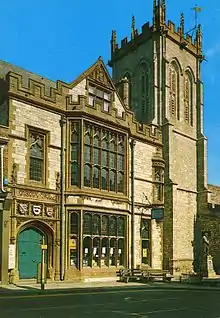 Victorian interior of the Dorset County Museum | |
| Established | 1846 |
|---|---|
| Location | Dorchester, Dorset |
| Coordinates | 50°42′55.9″N 2°26′14.0″W / 50.715528°N 2.437222°W |
| Visitors | 47,000 (2016) |
| Founder | Thomas Hardy and others. |
| Architect | G R Crickmay and Son |
The Dorset County Museum is located in Dorchester, Dorset, England. Founded in 1846, the museum covers the county of Dorset's history and environment. The current building was built in 1881 on the former site of the George Inn. The building was designed specifically to house the museum's collection and is in the neo-Gothic style.
The museum includes information and over 2 million artifacts associated with archaeology (e.g., Maiden Castle), geology (e.g., the Jurassic Coast), history, local writers (e.g. Thomas Hardy) and natural science. There are video displays, activity carts for children, and an audio guide. The collections include fossilised dinosaur footprints, Roman mosaics and original Thomas Hardy manuscripts.
Museum
The museum was founded in 1846, and includes two significant collections, the archive of Thomas Hardy's works and fossils from the Jurassic Coast. The total collection extends to approximately four million items. The museum is owned by the Dorset Natural History and Archaeological Society.[1] Many items in the museum's collection have been stored at the nearby All Saints' Church.[2] The museum was receiving approximately 45,000 visitors each year in 2014,[3] which had increased to 47,000 visitors in 2016.[4] TripAdvisor has awarded its Certificate of Excellence Award to the museum for four years in a row.[5]
In 2016, the museum unveiled plans for a £13 million extension which would include a learning centre, cafe, library and shop, allowing the Dorset Natural History and Archaeological Society's full collection to hold together in one building.[1] Three quarters of the funding for the extension would be put forward by the Heritage Lottery Fund, allowing much more of the collection to be viewed. Without the extension, less than two per cent of the museum's collection is on display.[6]
The museum closed in October 2018 to undergo refurbishment and the construction of the extension.[7][8] It reopened on 29 May 2021 after the re-opening was delayed due to the COVID-19 pandemic.[7] The cost of the work came to £16.4 million.[8]
Exhibits
Thomas Hardy was one of the founders of the museum, and over seven thousand artefacts related to him are in the museum's collection, including an 1874 first edition copy of Far From The Madding Crowd.[9] Other items in the Hardy archive include his handwritten manuscript for The Woodlanders, his sister's dress which is thought to be inspiration for the dress in Tess of the d'Urbervilles, and a reconstruction of Hardy's study.[10]
The Ancient Dorset Gallery was opened by Julian Richards in November 2015 and includes Viking historical artefacts from a nearby burial site. Other artefacts include pre-historic flint hand axes, a Roman glass bowl and an Iron Age bronze mirror.[11] The British Museum loaned three neolithic jadeite axes and mace heads to the museum to add to the display.[12]
In July 2016, the museum opened a gallery dedicated to the work of William Barnes, telling the story of his humble roots to his legacy in poetry, novels and music.[13] The gallery was opened by Bonny Sartin, lead singer of The Yetties.[14]
In 2018 Dippy, a plaster-cast of a dinosaur which was usually housed in the Natural History Museum, London, was exhibited at the Dorset County Museum from 10 February 2018 to the 7 May 2018.[15]

On 2 August 2019, Hinton St Mary villagers and the Chair of the Dorset Unitary Authority[16] were told at a closed-door meeting with the British Museum that the Hinton St Mary Mosaic would be partially returned to the Dorset County Museum. However, the head of Christ would not be returned, as the original would be “loaned to museums worldwide”. A replica would be given to the Dorset County Museum.[17][16] No answer was given to one attendee’s question that: “Given that she [a British Museum curator] boasted the fact that the replicas they made were indistinguishable from the originals, surely it would make more sense to send the replica around the world and keep the original safe in Dorset?”[18]
It is not clear whether the complete mosaic[19][20] or only a part of it will be displayed in Dorset County Museum. The Association for the Study and Preservation of Roman Mosaics has stated: “the mosaic possibly contains the only known representation of Christ in an ancient pavement, it is of unique importance not just in Britain but in the context of the Roman Empire as a whole, and merits being displayed in its entirety. It is insufficient to show the central roundel in isolation, however important. The full meaning of the pavement can be appreciated only if the whole of it is visible, including the accompanying heads and figure scenes”.[21]
In July 2022 the Blackmore Vale newspaper reported that "discussions are at an advanced stage with a view to bringing the important Roman artefact to the Dorset County Museum in Dorchester or another site."[22]
Building

Dorset County Museum is on High West Street in Dorchester, Dorset. Built from Portland stone in approximately 1881, it was designed by architects G R Crickmay and Son from Weymouth. The building is two storeys high with a slate roof, it has two stringcourses on the gently sloped walls, with hood moulds over the windows and a crenellated parapet. The frontage includes a 2-storey bay with 7 transom windows. At the top of the bay there is a trefoil-headed panel displaying the Dorchester coat of arms.[23] The cast-iron columns and the other metalwork in the aisled Victorian Hall were cast in Frome by Edward Cockey & Sons.
On the first floor there is an oriel window in the corner, above carved squinches. The door is to the left of the bay, displaying three coats of arms above. The building was designated Grade II listed building status on 8 May 1975, as part of a group with the nearby Shire Hall, Holy Trinity Church and St. Peter's Church.[23] To the rear of the building, the museum also owns John White's rectory, where he resided whilst obtaining charters for the colonisation of Massachusetts.[2]
References
- 1 2 "Plans unveiled for 'world-class' Dorset County Museum". BBC News. 9 August 2016. Retrieved 20 August 2016.
- 1 2 Bevins, Trevor (2 August 2016). "Museum showcases development plans". View News. Archived from the original on 19 September 2016. Retrieved 20 August 2016.
- ↑ "Dorset County Museum expansion plans unveiled". BBC News. 25 July 2014. Retrieved 20 August 2016.
- ↑ "Dorset County Museum displays plans for its £13million project". Backmore Vale Magazine. 3 August 2016. Retrieved 20 August 2016.
- ↑ "Dorset County Museum awarded TripAdvisor Certificate of Excellence for fourth year running". Blackmore Vale Magazine. 1 August 2016. Retrieved 20 August 2016.
- ↑ Rees, Jess (9 August 2016). "Dorset County Museum unveil plans to the public for Heritage Lottery Funded project". Dorset Echo. Retrieved 20 August 2016.
- 1 2 Alfonso, Marie-Claire (30 May 2021). "Dorset Museum reopens after £16m transformation". Dorset Echo. Retrieved 31 May 2021.
- 1 2 "Dorset Museum reopens after £16m transformation". BBC News. 29 May 2021. Retrieved 31 May 2021.
- ↑ "Thomas Hardy's Dorset inspirations". BBC News. 1 May 2015. Retrieved 20 August 2016.
- ↑ "Hardy archive Dorset museum secures £10.4m funding". BBC News. 20 May 2015. Retrieved 20 August 2016.
- ↑ "TV archaeologist Julian Richards opens Ancient Dorset Gallery at Dorset County Museum". Blackmore Vale Magazine. 10 November 2015. Retrieved 20 August 2016.
- ↑ "Work starts on new Dorset County Museum gallery dedicated to Dorset's ancient history". Blackmore Vale Magazine. 10 December 2014. Archived from the original on 28 December 2015. Retrieved 20 August 2016.
- ↑ Hogger, Harry (27 July 2016). "Inspiring the next generation of William Barnes fans". Dorset Echo. Retrieved 20 August 2016.
- ↑ "The Yetties' Bonny Sartin opens refurbished William Barnes Gallery at Dorset County Museum". Blackmore Vale Magazine. 29 June 2016. Retrieved 20 August 2016.
- ↑ "Dorset Museum | Celebrating 250 million years of history".
- 1 2 "Mosaic Update". The Arts Society Blackmore Vale. Retrieved 20 August 2021.
- ↑ "The Mosaic, Hinton St. Mary village newsletter, September 2019" (PDF). Hinton St Mary – an idyllic Dorset village. Retrieved 20 August 2021.
- ↑ "The Mosaic, Hinton St. Mary village newsletter, September 2019" (PDF). Hinton St Mary – an idyllic Dorset village. Retrieved 20 August 2021.
- ↑ "Object: The Hinton St Mary Mosaic". Archived copy on Archive.is of original British Museum webpage. Archived from the original on 5 August 2021. Retrieved 20 August 2021.
- ↑ "ASPROM factsheet: The Hinton St Mary mosaic in the British Museum, 2013" (PDF). The Association for the Study and Preservation of Roman Mosaics. Archived from the original (PDF) on 20 August 2021. Retrieved 20 August 2021.
- ↑ "ASPROM News archive, June 2010: Please sign the Hinton St Mary petition!". Retrieved 20 August 2021.
- ↑ "Second mosaic at Hinton St Mary leads to a history re-write". The Blackmore Vale, 2 July 2022. Retrieved 6 December 2022.
- 1 2 "Dorset County Museum". Historic England. Retrieved 20 August 2016.